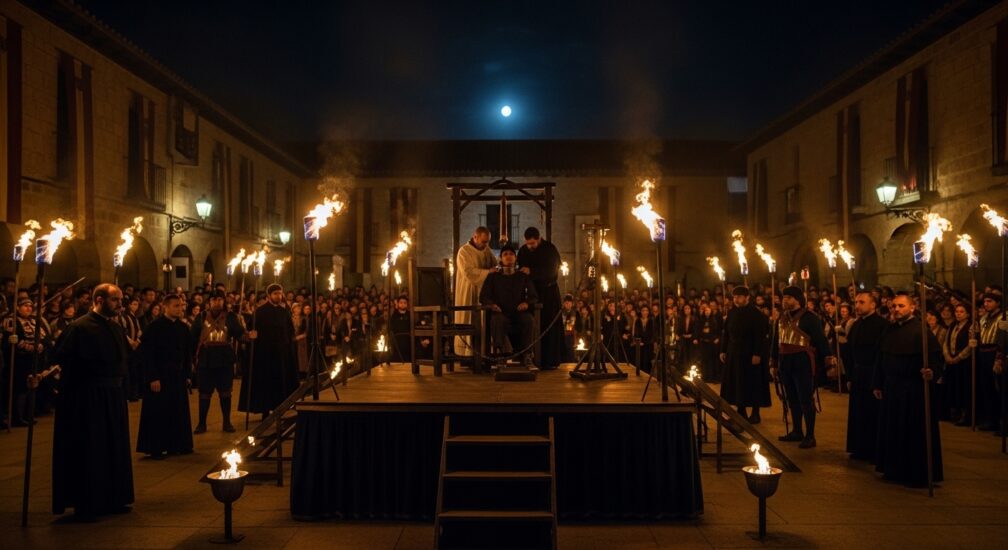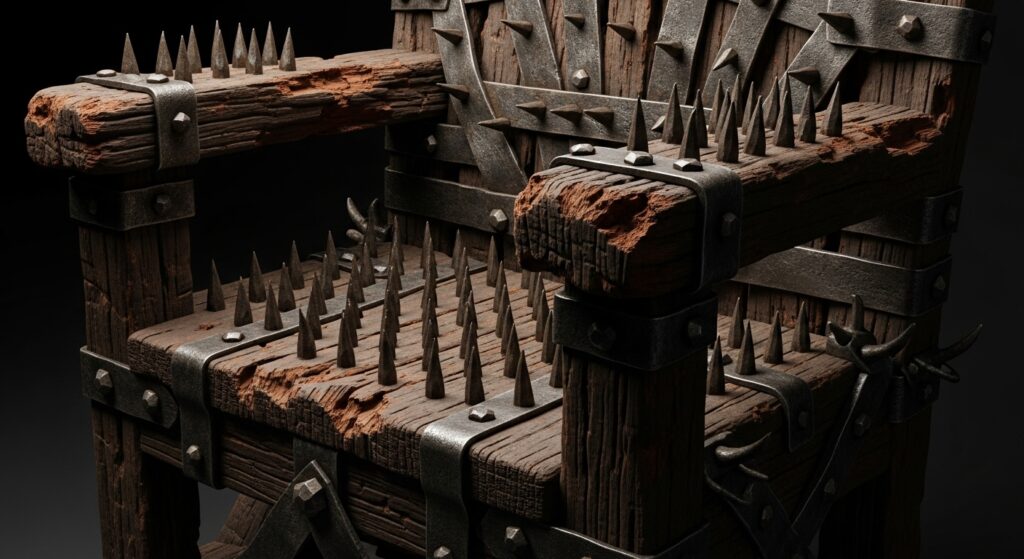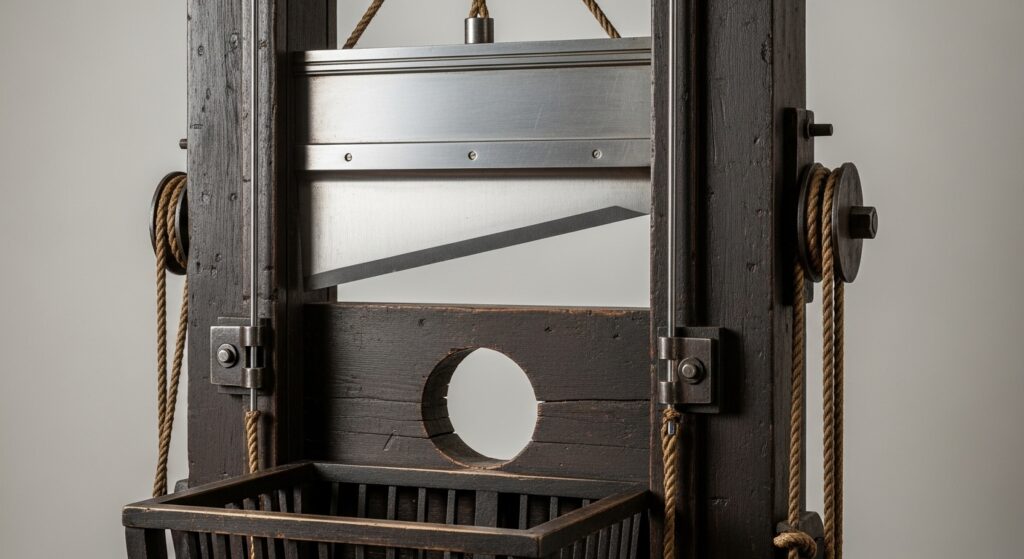The Meaning and Origins of the Garrote
To understand the garrote execution, one must first understand the garrote meaning. The word derives from the Spanish garrote, meaning “stick” or “club,” and originally referred to any instrument used to strangle or crush. In its earliest form, it was a simple cord or loop twisted around the victim’s neck until breath was gone – a primitive act of finality, both brutal and intimate.
As European systems of punishment evolved, so too did the garrote history. By the 18th century, Spain transformed this crude method into a mechanical device designed for swift, “civilized” death. The execution by garrote was considered more merciful than hanging or decapitation – a silent mechanism of justice, precise and controlled.
But beneath its polished iron and restrained design lay the same enduring truth: the garrote was a symbol of submission, where life ended not in chaos, but in state-imposed silence.
The Spanish Garrote: Instrument of Control and Fear
The Spanish garrote became the empire’s most enduring tool of punishment. Used from the era of the Inquisition to the late 20th century, it served both as execution device and instrument of authority. To die by the garrote was to face the full force of royal or governmental power – its calm efficiency reflected the order it sought to preserve.
Public garrote punishment was often performed in town squares, where citizens gathered to witness the moment justice tightened like a noose. For the monarchy, the device embodied obedience; for the people, it was a reminder of how swiftly power could close around one’s throat.
In Spain’s colonies – from Latin America to the Philippines – the garrote followed as a shadow of empire, its iron collar a symbol of imperial discipline and dominance. Through it, the idea of control became mechanical, its silence as commanding as any spoken decree.
The Design and Mechanics of the Garrote Machine
At the heart of the method was the garrote machine, an unsettling union of engineering and execution. The condemned was seated on a wooden or metal throne, their neck encircled by an iron collar attached to a post. Behind the chair, a crank or screw connected to a steel pin awaited its grim task. When turned by the executioner, it drove the pin forward into the base of the skull, crushing the vertebrae and sealing the throat in one motion.
This design gave the garrote torture device its reputation for efficiency. With each turn, the screw’s torque increased, compressing the neck until the spine collapsed. Early versions relied on twisting cords or rods; later, more elaborate models used levers and rotating mechanisms for precision.
Unlike the swinging blade of the guillotine, the garrote delivered death through pressure rather than spectacle. It was not speed that defined its horror, but control – each rotation of the screw measured and deliberate, a human hand guiding the final twist of life.
Execution by Garrote: The Theater of Silence
Though efficient, execution by garrote was never devoid of ritual. The condemned was led to the platform, often surrounded by guards, clergy, and officials of the crown. A hush fell over the crowd as the executioner fastened the iron collar. There was no rope to swing, no blade to gleam – only the slow tightening of the screw and the inevitable collapse of breath.
In these moments, the garrote became not merely a machine of death but an instrument of spectacle. The stillness that followed was both a warning and a performance – justice rendered through silence.
Witnesses described the final seconds as a struggle between endurance and surrender: the spine giving way, the body stiffening, and then motionless submission. The garrote execution was meant to deter rebellion and preserve order, its quiet finality more terrifying than any roar of pain.
Symbolism and Legacy of the Iron Collar
The iron collar of the garrote held meaning beyond its physical function. It symbolized the moral constraint imposed by authority – the moment when power achieved total control over the human form. Every turn of the crank represented a negotiation between law and life, between the body’s resistance and the state’s demand for obedience.
As both punishment and ritual, the garrote stood at the crossroads of justice and cruelty. Its simplicity concealed the ideology behind it: that death could be made rational, orderly, even moral. This notion of “humane” execution reflected the paradox of a society seeking refinement in torture – an attempt to civilize the act of killing without erasing its brutality.
In Spain’s long history, the garrote became a symbol of finality – the state’s iron handshake with mortality. It outlasted empires, kings, and revolutions, its silent turn marking the persistence of human faith in punishment as a form of control.
The Garrote in Modern Exhibits
Today, the garrote survives not in law, but in memory. At the Medieval Torture Museum in Chicago, visitors encounter the reconstructed garrote machine, its design revealing both the precision and coldness of judicial execution. The exhibit explores how Spain’s pursuit of order shaped the instruments of discipline across centuries.
At the Medieval Torture Museum in Los Angeles, the device is presented as a paradox – proof of humanity’s effort to merge mercy with mechanical efficiency. Here, the garrote torture device stands as a relic of authority, where moral purpose was measured by silence rather than compassion.
In the Medieval Torture Museum in St Augustine, authentic iron collars and chairs evoke the weight of control that once defined European justice. Visitors are invited to reflect on how punishment, once public and celebrated, evolved into an uneasy memory of repression and obedience.
For further exploration of historical devices, rituals, and the psychology of justice, the museum’s blog offers deeper insights into the instruments that shaped law, fear, and morality.
Reflection: Silence as the Language of Power
The garrote execution remains one of history’s most unsettling contradictions – a device meant to impose justice through stillness. Its quiet efficiency mirrored the political world that created it: one obsessed with order, finality, and the spectacle of obedience.
The garrote transformed death into ritual, and punishment into silence. It was not merely the body that it restrained, but the voice – the human will crushed between iron and authority. In this way, it became less a tool of law than a language of power, where control spoke louder than mercy.
Today, its presence in museums serves as a moral reflection. The garrote reminds us that the machinery of justice, however refined, can never escape the weight of its purpose. Each twist of the screw, each moment of breathless stillness, echoes a question that endures through centuries: how much of humanity can be preserved when justice demands silence?






